I’ve collected etchings since I was at school and I added a real gem – with an unexpected background – to my collection last month. I was drawn to it in the auction catalogue due to the incredibly intricate and fantastical design and the size – it measures a large 50cm (19.75in) by 37.5cm (14.75in). The description stated that it was by Twins Seven-Seven, a curious name that I hadn’t come across before. I was hooked, and luckily won the auction.
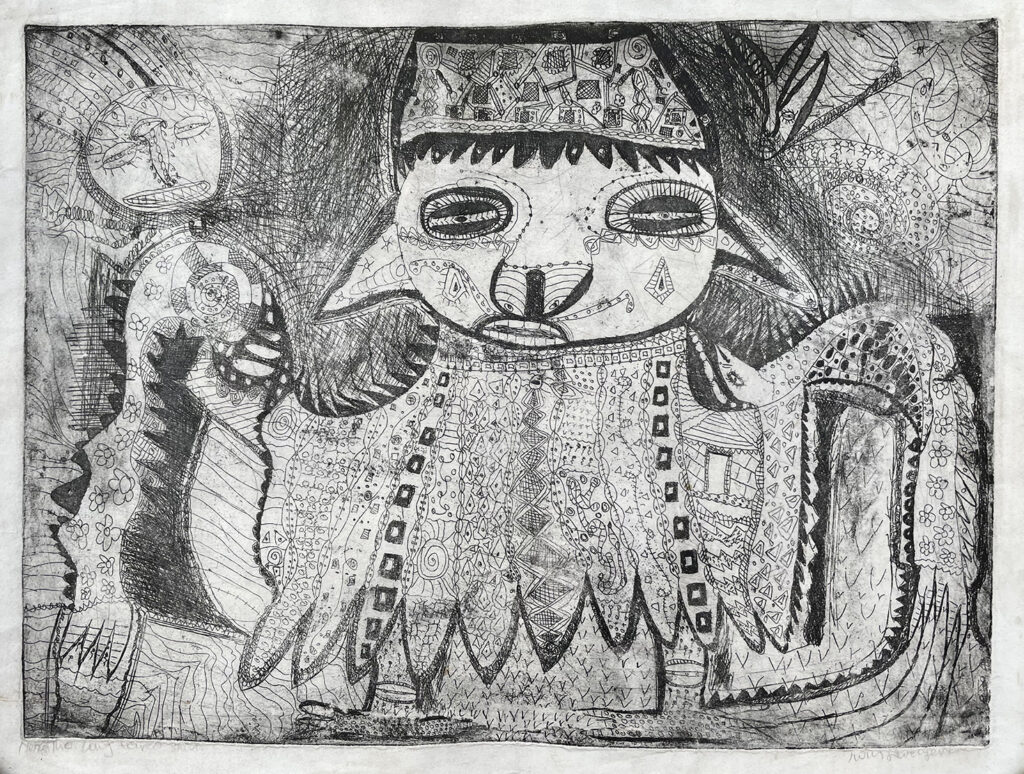
Who was Twins Seven-Seven?
Twins Seven-Seven (1944-2011) was born named Taiwo Olaniyi Oyewale-Toyeje Oyelale Osuntoki, in Ogidi, Nigeria. His parents were descended from Yoruba royalty, which later allowed him to take the titles of Chief and Prince. He renamed himself Ibeji Meje-Meje (Twins Seven-Seven), as he was the sole survivor of seven successive sets of twins. Nigeria has the highest frequency of twins in the world, and they are significant in Nigerian culture. He went to both primary and secondary school, but found himself drawn away from the strictures of classes towards art and music.
The Oshogbo School
He began his career as an itinerant singer and dancer and, after a performance in Summer 1964, he gate-crashed one of the Mbari Mbayo art workshops held in the city of Oshogbo by the German writers and scholars Georgina & Ulli Beier. They wanted to enable Nigerian artists to express themselves artistically, thus allowing them to develop and continue the story of Nigerian art and culture in the modern postwar age. All were welcome to join the experiment, regardless of background or experience. ‘Graduates’ included the now notable Jacob Afolabi, Yinka Adelemi, Rufus Ogundele, and Adelbisi Fabunmi.
Aged only 20 at the time, Twins Seven-Seven took to painting and drawing immediately and his characteristic expressive style soon developed. This style, and his motifs and subjects, are based in traditional Yoruba art and culture, from religion and folklore to his own dreams. But they are given a modern edge with complex, highly detailed forms that are seemingly unplanned and also crammed together in an abstract manner to the extent that they almost burst off the surface. His ghosts and gods are not scary or threatening, but are cheerful, almost whimsical, and optimistic.
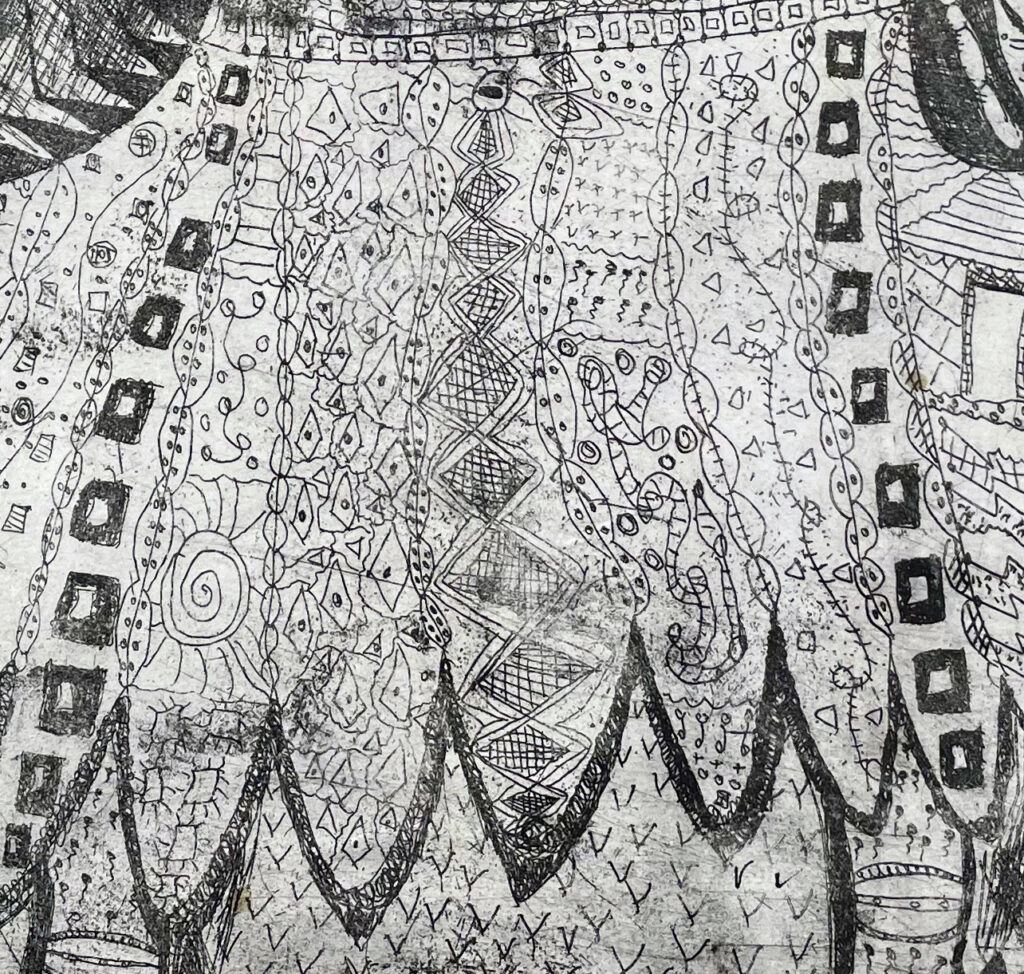
He said that he was heavily influenced by Amos Tutuola’s 1954 novel ‘My Life in the Bush of Ghosts’, which he was given by Georgina Beier. He refused to allow the influence of other, particularly European, modern artists to affect his work, famously refusing to attend a Picasso exhibition when he first visited the US. He soon became a star artist of what became known as the Oshogbo School, at the very genesis of postwar modern art in the newly independent Nigeria, and indeed Africa. The Oshogbo School thrived, even after the European ‘mentors’ of the Beiers left in 1966, and it continues to be both influential and important to contemporary African art today.
A True Polymath
Twins Seven-Seven didn’t just dedicate himself to producing ‘flat art’, and he also became a recognised and recorded singer, musician, actor, writer and poet. About him, The Philadelphia Museum of Art said in 2005, “He is a prominent artist as well as a bandleader, teacher, dancer, actor and spokesman for Yoruba culture. His artistic works reflect a personal cosmology, drawn from Yoruba myths and stories. Twins’ highly individual technique is the physical manifestation of a universe of potent forces in a state of constant transformation. The images themselves are wonderfully complex; forms collide with colors to reveal a mythopoetic world that demonstrates his unique imaginative power.” His biographer, Henry Glassie, an emeritus folklore professor at Indiana University, said that “Twins was the great modernist of the Yoruba tradition.”
He travelled widely, and visited or lived in Lagos, London, and the US during the 1970s. By the 1980s he had settled in the Philadelphia area, and his personal life became turbulent. A car crash in 1982 and drinking and gambling led him on a spiral downwards to the extent that he ended up tending a car park before he was ‘rescued’ by the owner of a Philadelphia gallery and design emporium called Material Culture. Steadied, he began to focus more on his art and music again.
International Recognition
Despite the ups and downs across his life, Twins Seven-Seven became highly successful and renowned internationally. His work was shown in galleries and museums across the world from the 1970s onwards, including at the Pompidou Centre in Paris, the MOMA in New York, the Field Museum in Chicago, the ULCA in Los Angeles, the Houston Contemporary Art Museum, and the National Museum of Art In Lagos, Nigeria. His work is in the permanent collections of the Smithsonian and the Philadelphia Museum of Art, amongst others. UNESCO named him an Artist for Peace in 2005, giving official international recognition to his lifetime’s work across the arts.
Good Providence & Provenance
The etching came with some paperwork, cleverly reunited with it by the wise auction house employee who found it amidst papers in the deceased estate. As well as a photograph of the piece, it comprises copies of the two double-sided typed A4 sheets that acted as a gallery catalogue for a hitherto unknown ‘Exhibition of Paintings by Twins Seven-Seven & Other Nigerian Artists’ held at the Amwell Gallery in Islington, London from 5th-23rd June 1973. There are a couple of paragraphs of introductory text, a list of the other artists, and a full catalogue of the works exhibited. My etching is listed as No.12: “The Long-eared Ghost’, Etching, 1964 (From original limited edition) 19.5in x 15in”. It cost £35 mounted then, so about £370 in today’s money. There are also a couple of pages of handwritten notes about Nigerian modern art written by the lady who bought it from the gallery. All this indicates that this etching journeyed from Nigeria and the artist’s direct ownership to a gallery in Islington in 1973, to the first owner that same year, to an auction of her deceased estate 47 years later – and then to me. Amazing!

But what’s interesting is the catalogue note that it’s from the ‘original limited edition’. That was an edition of 30 and, checking other examples illustrated online, they are numbered very clearly, and very differently, to mine which doesn’t appear to be numbered at all. Instead, where the edition number should be next to the title (above) is a small indecipherable group of letters that looks like ‘HonB’ or ‘NonB’. The etching is also signed by Twins Seven-Seven, in pencil.
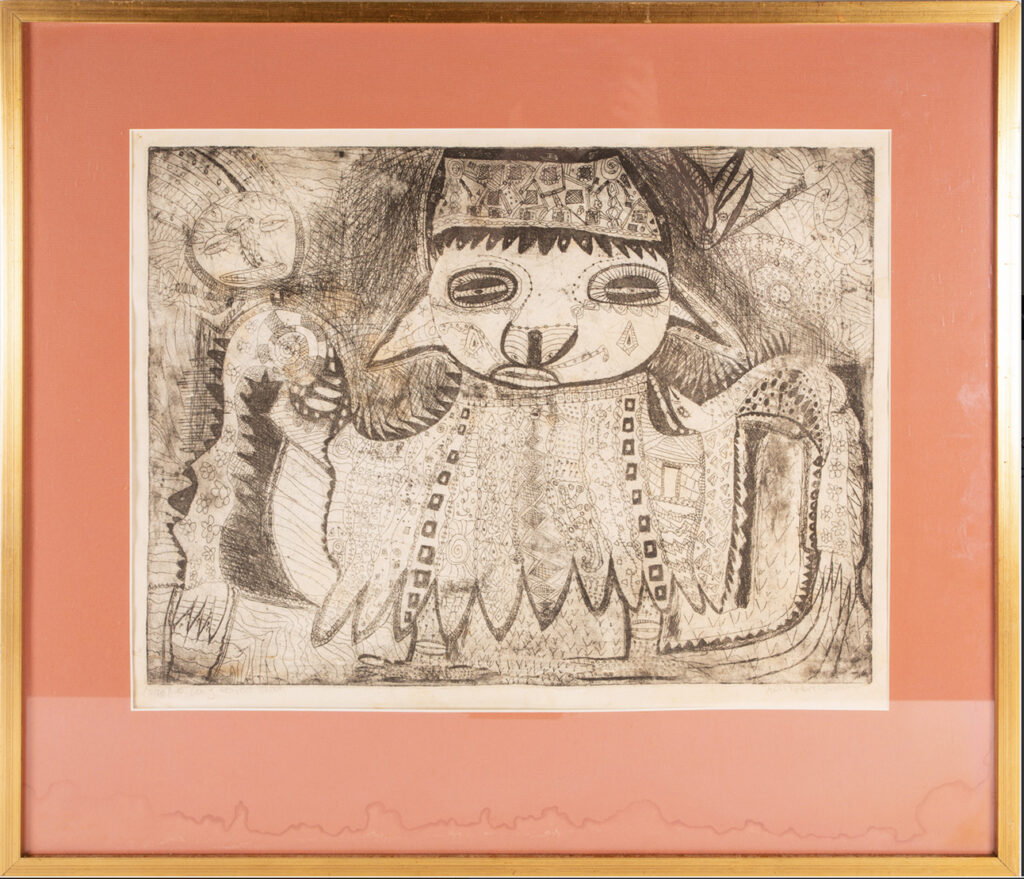
Restored & Refreshed
The first owner had had the print framed (above), but not well. As a result, the frame had opened and the print was dirty, yellowed, and suffering from some damp and tape stains. You can see how badly the rather lurid mount was damaged by water. So I removed it carefully and had the print professionally cleaned, stabilised, and resized to refresh and preserve it.
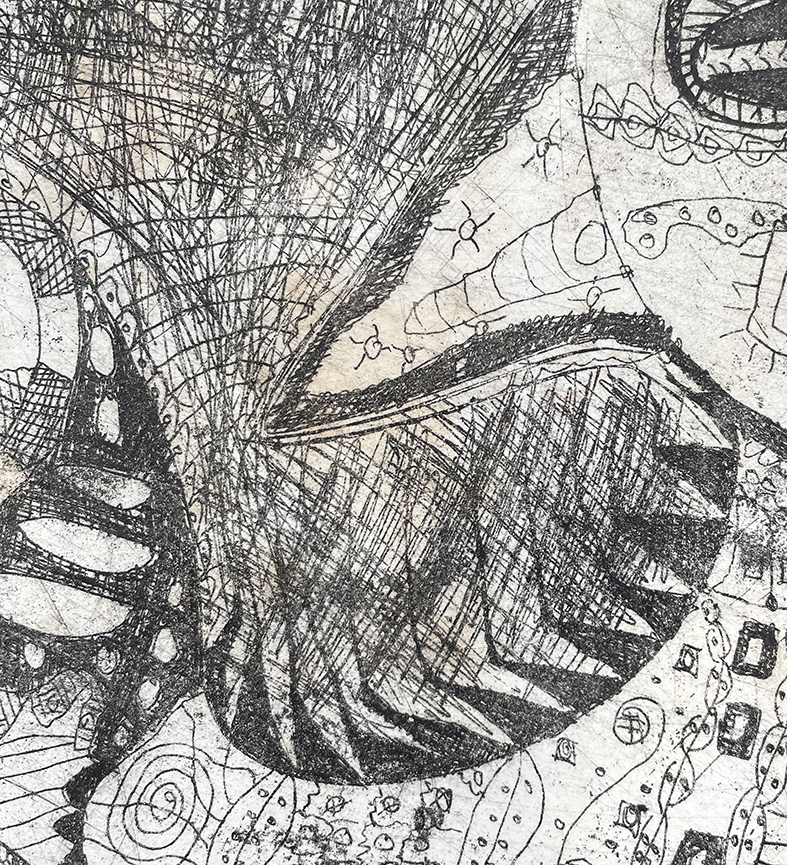
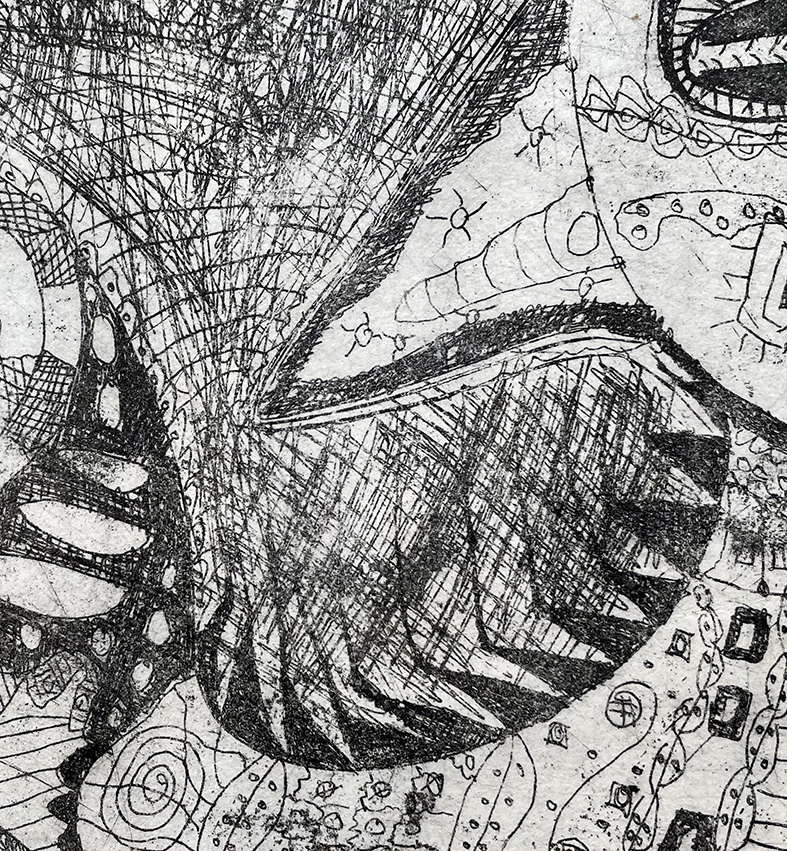
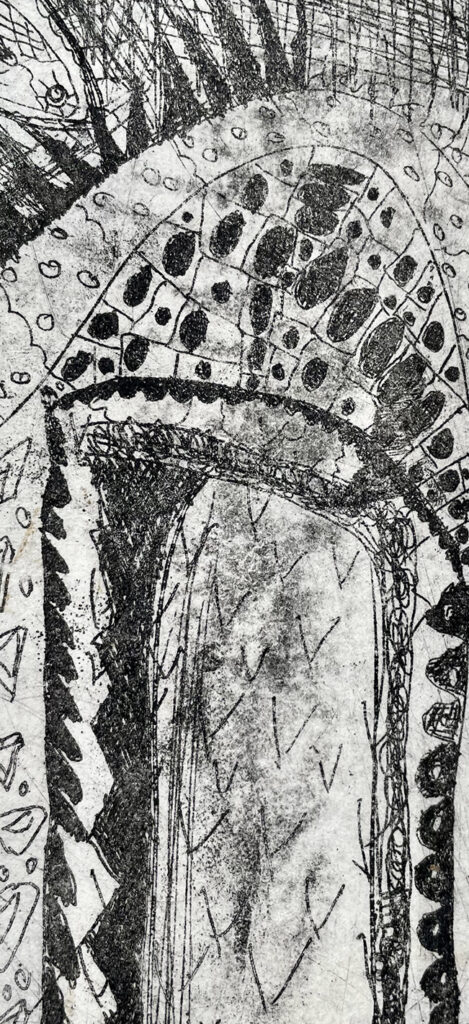
In doing this, my expert paper restorer noted that the plate hadn’t been cleaned properly between each print being taken, resulting in some cloudy and inky areas. Of course, having been at the Beiers’ art workshops for less than six months, the artist was still learning techniques, so this is excusable – especially with the complexity of etching. However, combined with the lack of numbering, I also wonder if this was a test print made before the main edition of 30, or one made by and for Twins Seven-Seven himself?
Overview
In all, it’s a huge, detailed and fascinating etching by one of the most celebrated members of the Oshogbo School that was hugely influential on postwar modern and contemporary African art. Having been made in 1964, it was right there at the beginning of the movement, and has close connections with the legendary figures Ulli & Georgina Beier and a seminal book that inspired the artist deeply throughout his life. It’s also a rare medium – Twins Seven-Seven practised etching comparatively briefly, producing only 24 different plates in the mid-late 1960s. As this dates from the first six months of his career as an artist, it must be one of the first of these. Its size, level of detail, date, and cultural connections are staggering, especially when you consider that it was executed by a 20 year old at the genesis of his career as an internationally renowned artist.
Read Twins Seven-Seven’s obituary in the New York Times here.
Prince Twins Seven-Seven: His Art, His Life in Nigeria, His Exile in America, by Henry Glassie, Indiana University Press, 2010.

